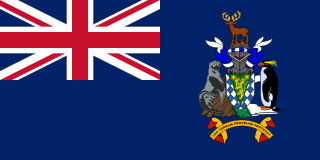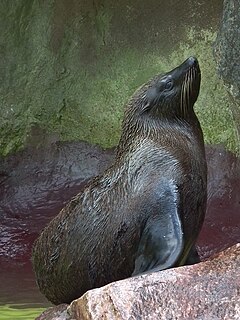
The Falkland Islands are located in the South Atlantic Ocean between 51°S and 53°S on a projection of the Patagonian Shelf, part of the South American continental shelf. In ancient geological time this shelf was part of Gondwana, and around 400 million years ago split from what is now Africa and drifted westwards from it. Today the islands are subjected to the Roaring Forties, winds that shape both their geography and climate.
The economy of the Falkland Islands, which first involved sealing, whaling and provisioning ships, became heavily dependent on sheep farming from the 1870s to 1980. It then diversified and now has income from tourism, commercial fishing, and servicing the fishing industry as well as agriculture. The Falkland Islands use the Falkland pound, which is backed by the British pound.

The Falklands War was a ten-week undeclared war between Argentina and the United Kingdom in 1982 over two British dependent territories in the South Atlantic: the Falkland Islands and its territorial dependency, South Georgia and the South Sandwich Islands.

South Georgia and the South Sandwich Islands (SGSSI) is a British Overseas Territory in the southern Atlantic Ocean. It is a remote and inhospitable collection of islands, consisting of South Georgia and a chain of smaller islands known as the South Sandwich Islands. South Georgia is 165 kilometres (103 mi) long and 35 kilometres (22 mi) wide and is by far the largest island in the territory. The South Sandwich Islands lie about 700 kilometres (430 mi) southeast of South Georgia. The territory's total land area is 3,903 km2 (1,507 sq mi). The Falkland Islands are about 1,300 kilometres (810 mi) west from its nearest point.

The gentoo penguin is a penguin species in the genus Pygoscelis, most closely related to the Adélie penguin and the chinstrap penguin. The earliest scientific description was made in 1781 by Johann Reinhold Forster with a type locality in the Falkland Islands. The species calls in a variety of ways, but the most frequently heard is a loud trumpeting, which the bird emits with its head thrown back.

The Falkland Islands wolf, also known as the warrah and occasionally as the Falkland Islands dog, Falkland Islands fox, warrah fox, or Antarctic wolf, was the only native land mammal of the Falkland Islands. This endemic canid became extinct in 1876, the first known canid to have become extinct in historical times.

Weddell Island is one of the Falkland Islands in the South Atlantic, lying off the southwest extremity of West Falkland. It is situated 1,545 km (960 mi) west-northwest of South Georgia Island, 1,165 km (724 mi) north of Livingston Island, 606 km (377 mi) northeast of Cape Horn, 358 km (222 mi) northeast of Isla de los Estados, and 510 km (320 mi) east of the Atlantic entrance to Magellan Strait.

Carcass Island is the largest of the West Point Island Group of the Falkland Islands.

Staats Island is an uninhabited island of the Beaver Island Group in the Falkland Islands. It lies between Beaver Island and Weddell Island, parallel to Tea Island and is 500 hectares in area.

Beaver Island is one of the Beaver Island group of Falkland Islands. It lies west of Weddell Island and south of New Island and has an area of 4,856 hectares.
Keppel Island is one of the Falkland Islands, lying between Saunders and Pebble islands, and near Golding Island to the north of West Falkland on Keppel Sound. It has an area of 3,626 hectares and its highest point, Mt. Keppel, is 341 metres (1,119 ft) high. There is a wide, flat valley in the centre of the island with several freshwater lakes. The central valley rises steeply to the south-west, west and north. The north-east is low-lying, with a deeply indented coastline.

Sea Lion Island is the largest of the Sea Lion Island Group of the Falkland Islands. It is 9 km2 (3 sq mi) in area. and lies 14 km (9 mi) southeast of Lafonia. It was designated a Ramsar site on 24 September 2001, and as an Important Bird Area. In 2017 the island was designated as a National Nature Reserve.

The South American fur seal breeds on the coasts of Peru, Chile, the Falkland Islands, Argentina, Uruguay and Brazil. The total population is around 250,000. However, population counts are sparse and outdated. Although Uruguay has long been considered to be the largest population of South American fur seals, recent census data indicates that the largest breeding population of A. a. australis are at the Falkland Islands followed by Uruguay. The population of South American fur seals in 1999 was estimated at 390,000, a drop from a 1987 estimate of 500,000 - however a paucity of population data, combined with inconsistent census methods, makes it difficult to interpret global population trends.

The Tale of Tsar Saltan is an opera in four acts with a prologue by Nikolai Rimsky-Korsakov. The libretto was written by Vladimir Belsky, and is based on the 1831 poem of the same name by Aleksandr Pushkin. The opera was composed in 1899–1900 to coincide with Pushkin's centenary, and was first performed in 1900 in Moscow, Russia.

The striated caracara is a bird of prey of the family Falconidae. In the Falkland Islands, it is known as the Johnny rook, probably named after the Johnny penguin.

The Falkland Islands is an archipelago in the South Atlantic Ocean on the Patagonian Shelf. The principal islands are about 300 mi (480 km) east of South America's southern Patagonian coast and about 752 mi (1,210 km) from Cape Dubouzet at the northern tip of the Antarctic Peninsula, at a latitude of about 52°S. The archipelago, with an area of 4,700 sq mi (12,000 km2), comprises East Falkland, West Falkland, and 776 smaller islands. As a British overseas territory, the Falklands have internal self-governance, but the United Kingdom takes responsibility for their defence and foreign affairs. The capital and largest settlement is Stanley on East Falkland.

Tea Island is one of the Falkland Islands. It is beside Staats Island, and is just to the south west of Weddell Island. It is shaped like an upside down "h". It has some of the few examples of Felton's Flower, a rare endemic Falkland species.
Bird Island is one of the Falkland Islands. It lies due south of West Falkland, near Port Stephens and Calm Head. It has been identified as an Important Bird Area (IBA) by BirdLife International.
Circum Peak is a mountain rising to 198 m (650 ft) in the southeast part of Weddell Island in the Falkland Islands. It is located at, which is 2.12 km (1.32 mi) southeast of Mount Weddell, and surmounts New Year Cove to the southeast and Gull Harbour to the northeast.

The COVID-19 pandemic in the Falkland Islands is part of the worldwide pandemic of coronavirus disease 2019 caused by severe acute respiratory syndrome coronavirus 2. The virus was confirmed to be in the islands on 3 April 2020. During the first wave, the number of cases peaked at 13, with all being from the military base at Mount Pleasant leaving none from the general population. All 13 patients recovered. On 10 November, a new case was discovered. As of 4 May 2022 a total of 195 people were confirmed to have been infected.















